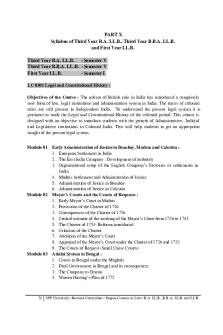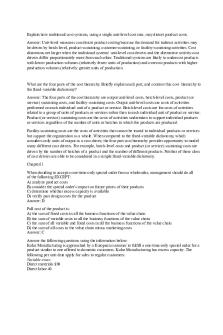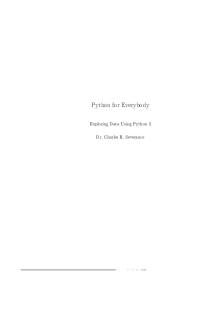Llb syllabus 1 - Nice PDF

| Title | Llb syllabus 1 - Nice |
|---|---|
| Author | nitin pawar |
| Course | LL.B |
| Institution | Savitribai Phule Pune University |
| Pages | 4 |
| File Size | 142.8 KB |
| File Type | |
| Total Downloads | 52 |
| Total Views | 144 |
Summary
Nice...
Description
PART X Syllabus of Third Year B.A. LL.B., Third Year B.B.A. LL.B. and First Year LL.B. Third Year B.A. LL.B. - Semester V Third Year B.B.A. LL.B. - Semester V First Year LL.B. - Semester I LC 0501 Legal and Constitutional History : Objectives of the Course : The advent of British rule in India has introduced a completely new form of law, legal institutions and administration system in India. The traces of colonial rules are still present in Independent India. To understand the present legal system it is pertinent to study the Legal and Constitutional History of the colonial period. This course is designed with an objective to introduce students with the growth of Administrative, Judicial and Legislative institutions in Colonial India. This will help students to get an appropriate insight of the present legal system. Module 01
Module 02
Module 03
74
Early Administration of Justice in Bombay, Madras and Calcutta : 1. European Settlement in India 2. The East India Company : Development of authority 3. Organisational setup of the English Company’s Factories or settlements in India 4. Madras Settlement and Administration of Justice 5. Administration of Justice in Bombay 6. Administration of Justice in Calcutta Mayor’s Courts and the Courts of Requests : 1. Early Mayor’s Court in Madras 2. Provisions of the Charter of 1726 3. Consequences of the Charter of 1726 4. Critical estimate of the working of the Mayor’s Court from 1726 to 1753 5. The Charter of 1753: Reforms introduced 6. Criticism of the Charter 7. Abolition of the Mayor’s Court 8. Appraisal of the Mayor’s Court under the Charter of 1726 and 1753 9. The Courts of Request (Small Cause Courts) Adalat System in Bengal : 1. Courts in Bengal under the Mughals 2. Dual Government in Bengal and its consequences 3. The Company as Diwan 4. Warren Hasting’s Plan of 1772
SPP University • Revised Curriculum • Degree Courses in Law • B.A. LL.B., B.B.A. LL.B. and LL.B.
Module 04
Module 05
Module 06
Module 07
75
5. Defect of the Plan 6. New Plan of 1774 7. Reorganisation of Adalats in 1780 8. Defects of the reorganization Plan 9. Reforms of 1781: Initiative of Impey and Warren Hastings 10. Reforms in the Administration of Criminal Justice The Regulating Act of 1773 : 1. Circumstances prior to the Act of 1773 2. Salient features of the Regulating Act, 1773 3. Legislative power under the Act, 1773 4. Charter of 1774 and the Supreme Court of Clacutta 5. Critical estimate of the Provisions of the Regulating Act, 1773 and the Charter of 1774 6. Trial of Raja Nand Kumar (1775) 7. “Kamaluddin” Case (1775) 8. “Patna” Case (1777-1779) 9. “Cossijurah” Case (1779-1780) 10. Salient features of the Settlement Act, 1781 11. Major defects of the Settlement Act, 1781 12. Supreme Court at Calcutta 13. Supreme Court at Madras and Bombay 14. Laws administered in the Supreme Court Judicial Measures of Cornwallis : 1. Company’s Government before Cornwallis 2. Important provisions of the Pitt’s Act, 1784 3. Judicial reform of Cornwallis a) Judicial Plan of 1787 b) Re-organisation of the Criminal Judicature c) Scheme of Criminal Judicature, 1790 4. Judicial Plan of 1793 5. Appraisal of the System of 1793 Establishment of High Courts : 1. The Indian High Courts Act, 1861 2. Letters patent establishing High Courts 3. The Indian High Courts Act, 1865 and of 1911 4. The Government of India Act, 1915 5. The Government of India Act, 1935 6. High Courts established during 1947 to 1950 Privy Council - Highest Court of Appeal : 1. The Origin of Privy Council 2. Appeal to the Privy Council (1726-1860) 3. Appeal to the Privy Council (1861-1949) 4. Precedential value of the Privy Council decisions
SPP University • Revised Curriculum • Degree Courses in Law • B.A. LL.B., B.B.A. LL.B. and LL.B.
Module 08
Module 09
Module 10
76
Federal Court of India : 1. Foundation of the Federal Court 2. Jurisdiction of the Federal Court a) Original Jurisdiction b) Appellate Jurisdiction c) Advisory Jurisdiction 3. Authority of law laid down by Federal Court 4. Abolition of Federal Court Evolution of Law through Legislation and Judicial Decisions in Colonial Period : 1. Process of Codification in India - (a) The Charter Act of 1833, (b) The First Law Commission, (c) The Second Law Commission, (d) The Third Law Commission, and (e) The Fourth Law Commission 2. Land Laws The Land Revenue Settlement, 1793 The Bengal Rent Act (Act X of 1859) 3. Legislation and Hindu Society The Sati Regulation Act, 1829 The Caste Disabilities Removal Act, 1850 Case 1. Charlotte Abraham v. Francis Abraham, (1861-1864) 9 MIA 199 (PC) Case 2. Miter Sen Singh v. Maqbul Hasan Khan, (1929-1930) 57 IA 313 4. The Hindu Widows Remarriage Act, 1856 Case 1. Bhagwandeen Doobey v. Myna Baee, (1866-1867) 11 MIA 487 Case 2. Debi Mangal Prasad Singh v. Mahadeo Prasad Singh, (1911-1912) 39 IA 121 Case 3. Venayeck Arundrow v. Luxumeebaee, (1861-1864) 9 MIA 520 5. Restitution of Conjugal Rights Muslim Law and restitution of conjugal rights Case 1. Mooshee Buzloor Ruheem v. Shumsoonnissa Begum, (1866-1867) 11 IA 551 Parsi Law and retitution of conjugal rights Case 1. Ardaseer Cursetjee v. Perozeboye, (1854-1857) 6 MIA 348 Hindu Law and restitution of conjugal rights Case1. Dadaji Bhikaji v. Rukmabai, ILA (1885-1886) 10 Bom 301 6. Justice Equity and Good Conscience Case 1. Manzur Hasan v. Muhammad Zaman, (1924- 1925) 52 IA 61 Case 2. Nawab Khwaja Muhammad Khan v. Nawab Husaini Begam, (19091910) 37 IA 152 Case 3. Gopeekrist Gosain v. Gungapersaud Gosain, (1854-1857) 6 MIA 53 Case 4. Gokul Chand v. Hukum Chand Nath Mal, (1920-1921) 48 IA 162 Constitutional History : 1. Morley-Minto Reforms and the Indian Council Act, 1909
SPP University • Revised Curriculum • Degree Courses in Law • B.A. LL.B., B.B.A. LL.B. and LL.B.
2. Montagu-Chelmsford Report and the Government of India Act, 1919 a) Main features of the system introduced by the Act of 1919 b) Shortcomings of the Act of 1919 3. The Simon Commission Report 4. The Nehru Report, 1928 5. Communal Award and Poona Pact 6. The Civil Disobedience Movement 7. The Government of India Act, 1935 a) Main features of the Government of India Act, 1935 b) Opposition to the Government of India Act, 1935 c) Defects of the Government of India Act, 1935 Recommended Readings : 1. M.P. Jain, Outline of Indian Legal and Constitutional History, LexisNexis (2014). 2. Sumeet Malik, V.D. Kulshreshths’s Landmarks in Indian Legal and Constitutional History, Eastern Book Company (2012). 3. Nilakshi Jatar and Laxmi Paranjape, Legal History- Evolution of the Indian Legal System, Eastern Book Company, (2012). 4. Rama Jois, Legal and Constitutional History of India, Universal Law Publishing, (2016) 5. S.B. Shiva Rao, The Framing of the Indian Constitution, Vols. I and V, the Indian Institute of Public Administration, New Delhi (1966). 6. Granville Austin, The Indian Constitution - Cornerstone of a Nation, 5th Edition, Oxford University Press, New Delhi,( 2002). 7. E.J. Rapson, Cambridge, History of India, 1992, (Vol. I - VI). LC 0502 Family Law I : Objectives of the Course : The personal law applicable to Hindus, Muslims, Christians, Parsis and other denominations is not fully codified. While these personal laws are similar in their essential broad underlying principles, they are much different in their details. Personal law is applicable not only to aspects of family relations, viz. marriage and divorce, support and maintenance, children and their custody and guardianship, adoption and the like, but also to law relating to property, viz. joint family systems, devolution to property upon death of a person. The differences in the provisions applicable to different denominations arise from the history and growth of these laws over centuries. This course covers the history and development of the principles and provisions of different personal laws, and the sources from which these laws are derived. It primarily comprises the laws applicable to family relations: marriage and divorce, maintenance, alimony, adoption and guardianship. It also lays emphasis on the general law applicable to all persons: the Special Marriage Act, 1963 and the Foreign Marriages Act, 1969. The course familiarises the students to the differences in the various systems, and to understand the reasons, merits and demerits of the various provisions. Study of this subject should enable the students to view family law not merely as a separate system of personal laws based upon religious beliefs, but as one cutting 77
SPP University • Revised Curriculum • Degree Courses in Law • B.A. LL.B., B.B.A. LL.B. and LL.B....
Similar Free PDFs

Llb syllabus 1 - Nice
- 4 Pages

LLB Syllabus Sambalpur University
- 21 Pages

Bballb - BBA LLB syllabus
- 65 Pages

3 Yrs LLB Syllabus
- 66 Pages

LLb third Year Syllabus
- 27 Pages

Du llb syllabus
- 3 Pages

5 Years syllabus BLS llb
- 60 Pages

CCS University Meerut syllabus LLB @
- 47 Pages

Ba llb first semester syllabus
- 11 Pages

LLB5ydc - SYLLABUS COPY FOR LLB 5YDC
- 51 Pages

Ch11 - nice
- 16 Pages

Political Science LLb 1
- 15 Pages

AU 3-Year-LLB-Syllabus-02012 014
- 57 Pages

Pythonlearn - Nice
- 249 Pages
Popular Institutions
- Tinajero National High School - Annex
- Politeknik Caltex Riau
- Yokohama City University
- SGT University
- University of Al-Qadisiyah
- Divine Word College of Vigan
- Techniek College Rotterdam
- Universidade de Santiago
- Universiti Teknologi MARA Cawangan Johor Kampus Pasir Gudang
- Poltekkes Kemenkes Yogyakarta
- Baguio City National High School
- Colegio san marcos
- preparatoria uno
- Centro de Bachillerato Tecnológico Industrial y de Servicios No. 107
- Dalian Maritime University
- Quang Trung Secondary School
- Colegio Tecnológico en Informática
- Corporación Regional de Educación Superior
- Grupo CEDVA
- Dar Al Uloom University
- Centro de Estudios Preuniversitarios de la Universidad Nacional de Ingeniería
- 上智大学
- Aakash International School, Nuna Majara
- San Felipe Neri Catholic School
- Kang Chiao International School - New Taipei City
- Misamis Occidental National High School
- Institución Educativa Escuela Normal Juan Ladrilleros
- Kolehiyo ng Pantukan
- Batanes State College
- Instituto Continental
- Sekolah Menengah Kejuruan Kesehatan Kaltara (Tarakan)
- Colegio de La Inmaculada Concepcion - Cebu

